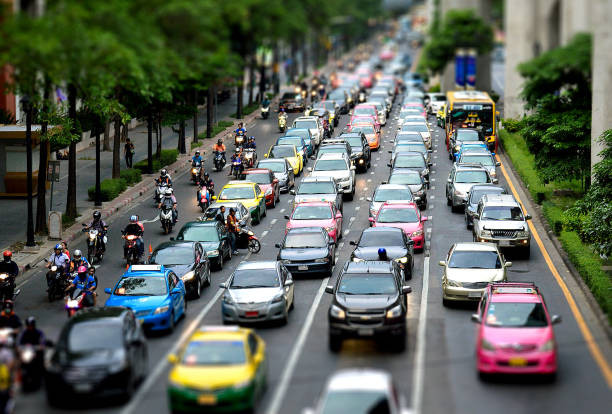What to Focus on When Driving on a Busy Road
Driving on busy roads can be a challenging experience, especially for new drivers. The increased traffic, numerous distractions, and fast-paced environment require heightened attention and advanced driving skills. At Get Drivers Ed, we understand the challenges of navigating busy roads and aim to equip our students with the knowledge and confidence needed to drive safely and effectively. Here’s a comprehensive guide on what to focus on when driving on busy roads.
Stay Alert and Focused
Eliminate Distractions
Distractions are one of the leading causes of accidents, particularly on busy roads. To ensure your safety and that of others, it’s crucial to eliminate distractions while driving. This includes:
No Phone Use: Avoid using your phone for calls, texts, or navigation while driving. If necessary, use hands-free devices.
Limit Passengers: Minimize the number of passengers to reduce distractions, especially if you are a new driver.
Avoid Eating and Drinking: Eating or drinking while driving can take your focus off the road. Wait until you are parked to enjoy your meal or beverage.
Maintain Focus on the Road
Keeping your eyes on the road is essential for safe driving. Constantly scan your surroundings to anticipate any potential hazards. This involves:
Mirror Checks: Regularly check your rearview and side mirrors to stay aware of the traffic behind and beside you.
Blind Spot Monitoring: Always check your blind spots before changing lanes or merging.
Look Ahead: Focus on the road ahead, not just the car in front of you. This helps you anticipate traffic flow and react to any sudden changes.
Maintain a Safe Following Distance
Understand the Three-Second Rule
Maintaining a safe following distance is crucial to prevent rear-end collisions. The three-second rule is a simple way to ensure you have enough space to react to the vehicle in front of you. To apply this rule:
Choose a Fixed Point: Select a stationary object on the side of the road, such as a sign or tree.
Count Seconds: As the vehicle in front passes the object, start counting seconds. You should reach the object no less than three seconds later.
Adjust for Conditions: Increase the following distance in adverse weather conditions or heavy traffic to account for longer stopping distances.
Stay in Your Lane
Proper Lane Discipline
Maintaining proper lane discipline is essential for safe driving on busy roads. This involves:
Stay Centered: Keep your vehicle centered in your lane to avoid drifting into adjacent lanes.
Use Turn Signals: Always use your turn signals to indicate lane changes or turns, giving other drivers enough time to react.
Avoid Lane Hopping: Constantly switching lanes can be dangerous and is often unnecessary. Stick to one lane and only change when needed.
Be Aware of Lane Markings
Understanding and obeying lane markings is crucial for safe driving. This includes:
Solid Lines: Do not cross solid lines, as they indicate areas where lane changes are prohibited.
Dashed Lines: Lane changes are allowed when safe to do so if the line is dashed.
Double Yellow Lines: These indicate no-passing zones and should not be crossed.
Anticipate the Actions of Others
Predictive Driving
Predictive driving involves anticipating the actions of other road users and being prepared to react accordingly. This helps prevent accidents and ensures a smoother driving experience. Key aspects include:
Watch for Signals: Pay attention to the turn signals, brake lights, and hand signals of other drivers and cyclists.
Observe Behavior: Notice the behavior of other drivers. Erratic or aggressive driving can indicate potential hazards.
Yield When Necessary: Be prepared to yield the right of way to other vehicles and pedestrians, especially at intersections and crosswalks.
Use Defensive Driving Techniques
Stay Calm and Patient
Defensive driving is about staying calm and patient, even in stressful situations. This involves:
Avoid Aggression: Do not engage in aggressive driving behaviors such as tailgating, honking excessively, or making rude gestures.
Give Space: Allow other drivers to merge or change lanes without reacting aggressively.
Plan Ahead: Leave early to avoid the stress of running late, which can lead to reckless driving.
Be Prepared for the Unexpected
Always be ready for unexpected situations. This includes:
Emergency Maneuvers: Practice emergency maneuvers like sudden stops or quick lane changes in a safe environment.
Know Your Exits: Familiarize yourself with the exits and alternative routes in case of heavy traffic or road closures.
Stay Informed: Keep updated on traffic conditions and road work in your area.
Conclusion
Driving on busy roads requires a combination of focus, patience, and defensive driving techniques. By staying alert, maintaining a safe following distance, practicing proper lane discipline, anticipating the actions of others, and using defensive driving techniques, you can navigate busy roads safely and confidently. At Get Drivers Ed, we are committed to providing comprehensive driver education that prepares you for all driving conditions.
Ready to enhance your driving skills and gain confidence on busy roads? Enroll in our comprehensive driver education courses today at Get Drivers Ed. Let us help you become a safe and responsible driver.

